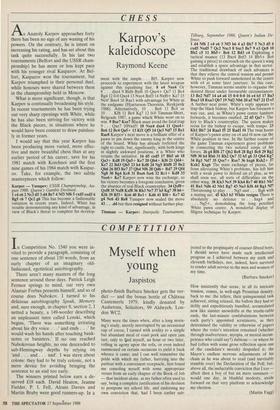CHESS
Karpov's kaleidoscope
Raymond Keene
As Anatoly Karpov approaches forty there has been no sign of any waning of his powers. On the contrary, he is intent on increasing his rating, and has set about this
task quite successfully. In his last two tournaments (Belfort and the USSR cham- pionship) he has more or less kept pace with his younger rival Kasparov. At Bel- fort, Kasparov won the tournament, but Karpov triumphed in their personal duel, while honours were shared between them in the championship held in Moscow. What is more significant, though, is that Karpov is continually broadening his style.
In recent tournaments he has been trying out very sharp openings with White, while he has also been striving for victory with the Black pieces, in situations where he would have been content to draw painless- ly in former years.
I would say that this year Karpov has been producing more varied, more effec- tive and more beautiful chess than at any earlier period of his career, save for his 1981 match with Korchnoi and the first nine games of his 1984 match with Kaspar- ov. Take, for example, the two subtle masterpieces which follow:
Karpov — Yusupov: USSR Championship, Au- gust 1988; Queen's Gambit Declined.
1 c4 e6 2 Nc3 d5 3 d4 Be7 4 Nf3 Nf6 5 cxd5 exd5 6 Bg5 c6 7 Qc2 g6 This has become a fashionable variation in recent years. Indeed, White has trouble demonstrating any kind of advantage, in view of Black's threat to complete his develop- ment with the simple . . . Bf5. Karpov now proceeds to experiment with the latest weapon against this equalising line. 8 e4 Nxe4 Or 8 . . . dxe4 9 Bxf6 Bxf6 10 Qxe4+ Qe7 11 Bc4 Bg4 12 0-0 Qxe4 13 Nxe4 Bxf3 14 Nxf6+ Ke7 15 Ne4! Bxe4 16 Rael with advantage for White in the endgame (Hjartarson-Thorstein, Reykjavik 1988). Alternatively, 10 . . . Be6 11 Bc4 or 10 . . . Kf8 11 Bc4 Kg7 12 0-0 Timman-Short, Belgrade 1987, a game which White went on to win. 9 Bxe7 Kxe7 Black must avoid the fatal trap 9 . . . Qxe7 lONxdS! 10 Nxe4 dxe4 11 Qxe4+ Be6 12 Bc4 Qa5+ 13 Kfl Qf5 14 Qe3 Nd7 15 Rel RaeS Karpov's next move is a brilliant offer of a pawn to pin down the enemy king in the centre of the board. White has already forfeited the right to castle, but, significantly, with both kings in slightly awkward positions, it is White who retains the initiative. 16 d5 cxd5 17 Bb5 a6 18 Qa3+ Kd8 19 Qa5+ Ke7 20 Qb4+ Kf6 21 Qd4+ Ke7 22 Bd3 Qh5 23 h4 Kd8 24 Ng5 Rhf8 25 Be2 Qh6 26 Bf3 Re7 27 Qb4 Nf6 28 Qd6+ Rd7 29 Qf4 Ng8 30 Bg4 Kc8 31 Bxe6 fxe6 32 Rcl + Kd8 33 Nxe6+ Ke7 Karpov now wins the exchange, so his victory becomes a foregone conclusion, given the absence of real Black counterplay. 34 Qxf8+ Qxf8 35 NxfB KxfS 36 Rh3 Ne7 37 h5 Kg7 38 h6+ Kf6 39 Rf3+ Ke6 40 Rel+ Kd6 41 Rf6+ Kc7 42 g4 Nc6 43 Re8 Yusupov now sealed the move 43 . . .d4 but then resigned without further play.
Timman — Karpov: Interpolis Tournament,
Tilburg, September 1988; Queen's Indian De- fence.
1 d4 Nf6 2 c4 e6 3 Nf3 b6 4 a3 Bb7 5 Nc3 d5 6 cxd5 NxdS 7 Qc2 Nxc3 8 bxc3 Be7 9 e3 Qc8 10 Bb2 c5 11 Bb5+ Bc6 12 Bd3 c4 Exploiting a tactical nuance (13 Bxc4 Bxf3 14 Bb5+ Bc6 gaining a piece) to encroach on the queen's wing and establish a space advantage in that sector. The traditional drawback of such advances is that they relieve the central tension and permit White to push forward unmolested in the centre with e4 at some later juncture. In this case, however, Timman seems unable to organise the desired thrust under favourable circumstances. 13 Be2 Nd7 14 a4 a6 15 0-0 0-0 16 e4 b5 17 Ba3 Bxa3 18 Rxa3 Qb7 19 Nd2 Nb6 20 a5 Nd7 21 t'3 e5 A further neat point. White's reply appears to trap the black bishop, but Karpov has foreseen a way out, and, as White's pawn centre lumbers forwards, it becomes ossified. 22 d5 Qa7+ The key to Black's counterplay. The queen makes room for the bishop to escape, with tempo. 23 Khl Bbl 24 Raal f5 25 Radl f4 The twin horns of Karpov's pawn army on c4 and f4 now cut the White position in two. In the further course of the game Timman experiences grave problems in connecting the two isolated corps of his forces. 26 g4 Rf6 27 Qb2 Re8 28 Rgl Bc8 29 Rg2 Nfil 30 h4 Rh6 31 Rh2 Qe7 32 h5 g6 33 Qb4 Kg7 34 Rgl Nd7 35 Qxe7+ Rxe7 36 hxg6 Rxh2+ 37 Kxh2 Kxg6 The mass exchange of pieces, far from alleviating White's problems, has left him with a weak pawn to defend on a5 plus, as we shall soon see, all sorts of difficulties on the other wing. 38 Kh3 Nc5 39 Kh4 Rc7 40 Rbl Nb7 41 Ral Nd6 42 Nbl Rg7 43 Na3 Kf6 44 Rgl NI7 Threatening to play . . . Ng5 and . . . Rg6 with a mating net. 45 Kh3 h5 White resigns There is absolutely no defence to . . . hxg4 and . . . Ng5+ , demolishing the long petrified White pawn centre. A wonderful display of filigree technique by Karpov.


































































 Previous page
Previous page